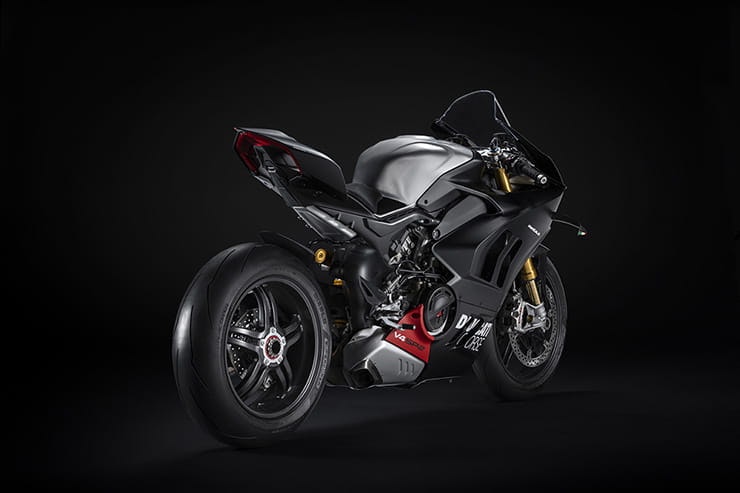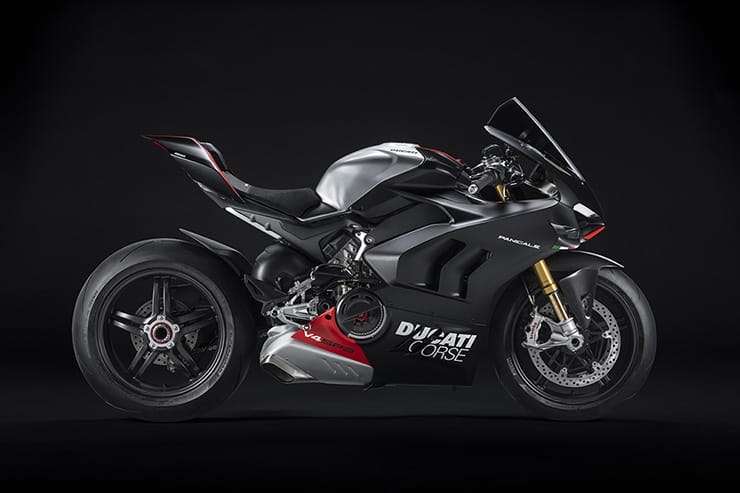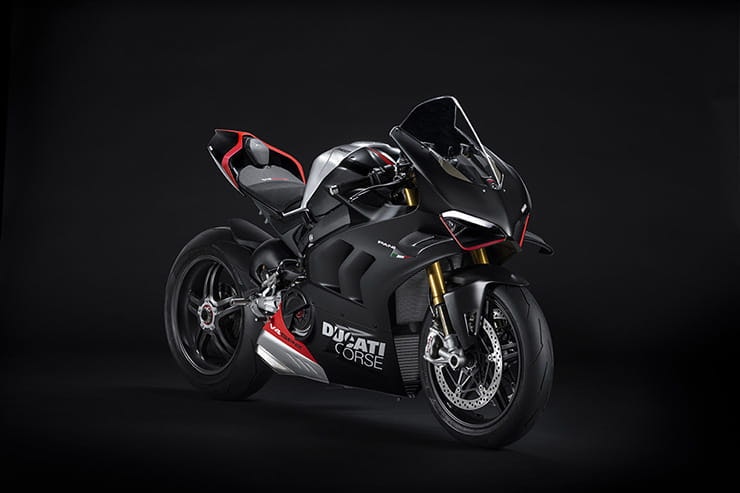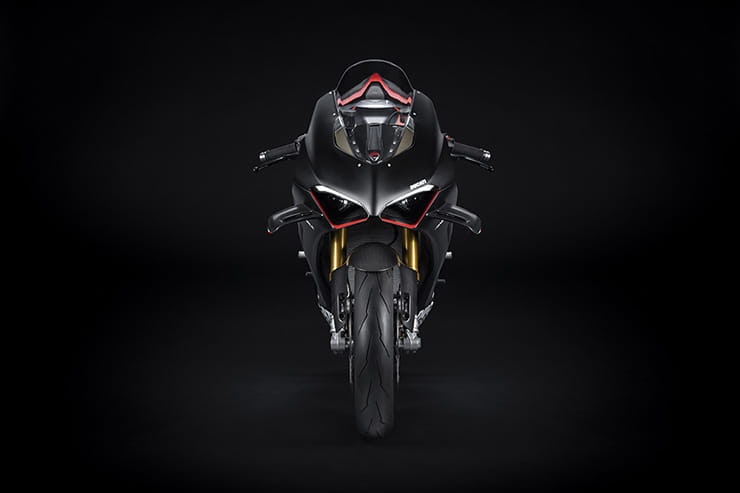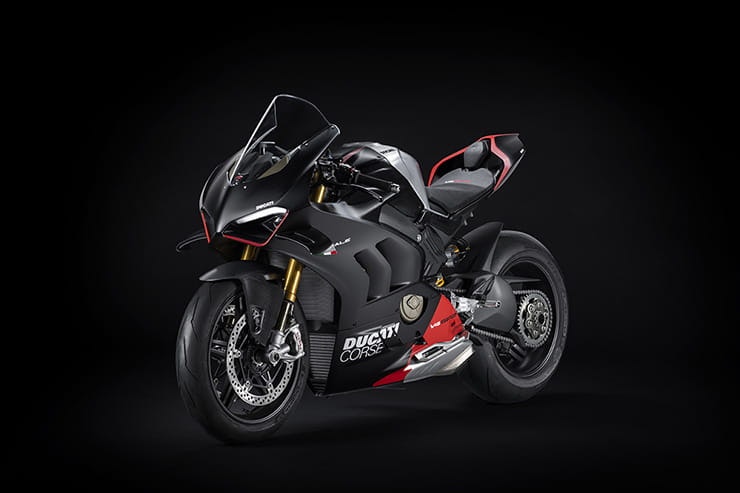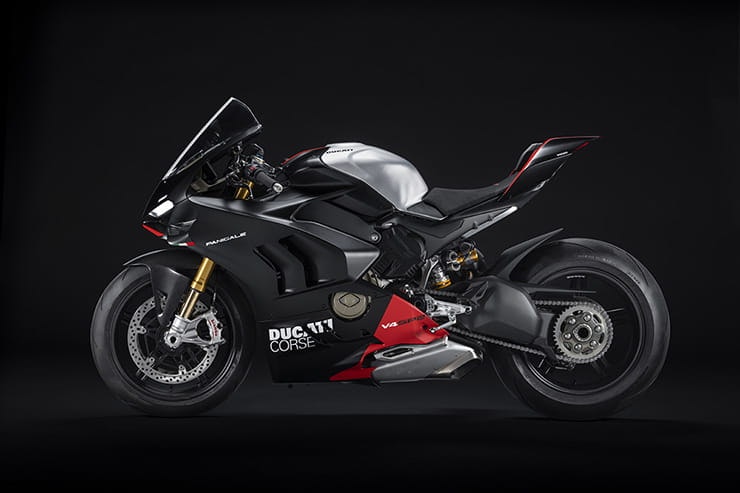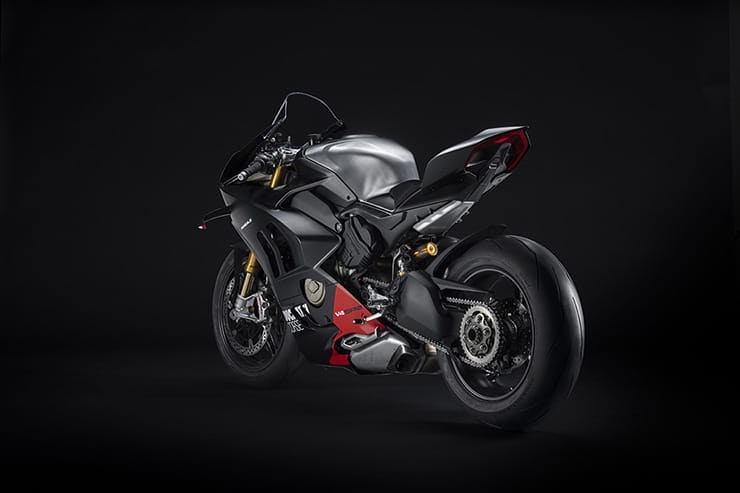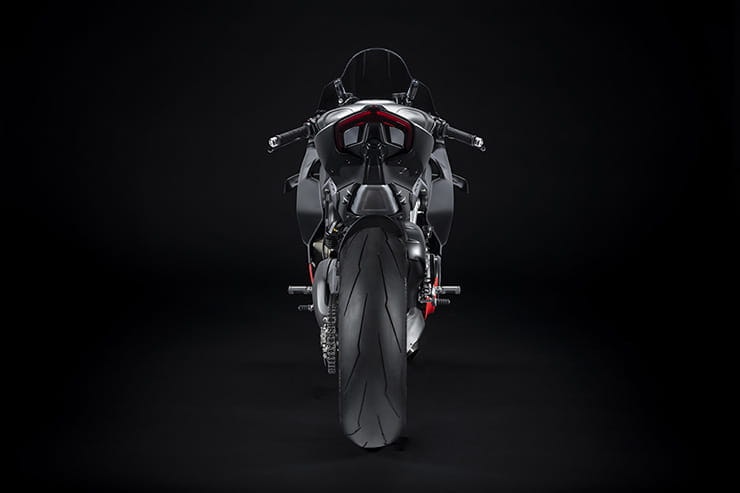Ducati Panigale V4 SP2 (2022) - Review
BikeSocial Road Tester
05.07.2022
Technical Review: Ben Purvis
Rider Review: Adam 'Chad' Child
With no homologation-special Panigale V4 R in the 2022 range Ducati’s new Panigale V4 SP2 sits below only the uber-expensive Superleggera V4 in the company’s superbike line-up – combining exotic materials, paintwork inspired by Ducati Corse’s pre-season test livery and track-oriented electronics with the latest updates applied to the more mainstream models.
Ever since Ducati revived the ‘SP’ branding on the 2021 Panigale V4, bringing back a term that was familiar on earlier superbikes like the 851 and 916, it was clear that the door was open to evolve the machine with an SP2 version, although few would have predicted that it would appear just a year after the original’s launch.
The £34,295 SP2’s early arrival is driven by the fact that the bike it’s based on, the normal Panigale V4, has been given subtle but significant improvements this year, creating a situation where the cheaper model was more powerful than the SP and featured more up-to-date styling.We tested both the old and new Panigale back-to-back and discovered the new model is close to one second faster than the previous model.
Changes on that front include a reshaped fuel tank, as on the base 2022 Panigale V4 but finished in bare aluminium to contrast with the black and red ‘Winter Test’ graphics, plus a redesigned seat to improve ergonomics. The winglets – slimmer than before to reduce drag but with no loss in downforce – are carbon-fibre, as is the front mudguard and both wheels, saving 1.4kg in rotating, unsprung mass compared to even the forged alloys on the Panigale V4 S. These rims, identical to those on the original SP, reduce front inertia by 26% and rear by 46% compared to the forged aluminium S wheels.
Like the standard 2022 Panigale V4, the lower fairing is also redesigned, with additional cooling gills added.
Quicker on track than the standard model
Easier to turn and stop, aided by the carbon-fibre wheels
Lovely sounding dry clutch
‘Winter Test’ graphics leave no doubt that the SP2 is something special
Resale value is likely to be strong
Changes aren’t that significant compared to the previous Panigale V4 SP
Buyers of the first-generation bike might feel short-changed by updates coming so soon
Hefty price premium over the Panigale V4 and V4 S and being limited, it’ll sell out quickly
Open dry clutch cover is for track use only
Clutch lever is heavier than standard
New Ducati Panigale V4 SP2 | The Beauty of Speed
The MotoGP-derived 1,103 cm3 Desmosedici Stradale: an improved V4 with a counter-rotating crankshaft, robust torque from low revs, capable of expressing the pure racing spirit of the bike on the track.
REVIEW: Ducati Panigale V4 SP2
With no homologation-special Panigale V4 R in the 2022 range, Ducati’s new Panigale V4 SP2 sits below only the uber-expensive Superleggera V4 in the company’s superbike line-up, so when the invite came in we packed Adam ‘Chad’ Child off to Misano to do the honours.
Power and torque
In line with the standard 2022 Panigale V4 and V4 S the new SP2 gets a 1.5hp boost for a maximum of 215.5hp at 13,000rpm, with max torque of 91.2lbft at 9500rpm, although as usual Ducati’s measurements are in the slightly smaller metric horses rather than our brawnier imperial ones. Using the more old-fashioned measurement, the 2022 bike makes 212.5hp, up from 211hp, although if your ability is high enough to spot that difference you should probably apply for a position riding a WSBK Panigale rather than a road-going one.
Engine, gearbox, and exhaust
The SP2’s engine is identical to the standard 2022 Panigale V4’s, complete with four riding modes – Street, Sport, Race A and Race B – but as on the previous SP it drives through an STM-EVO dry slipper clutch, designed to improve engine-braking behaviour, and reduce the chance of locking the rear wheel. You can even order different secondary clutch springs from the accessories catalogue to tailor the mechanical element of the engine braking characteristics.
The gearbox is from the stock Panigale, but the SP2’s final drive is through a lighter 520 chain, with specific sprockets to match.
Although there’s no change to the exhaust system there’s an optional titanium Akrapovič pipe, for track use only, with twin high-level silencers. It bumps the power up to 228hp (or 225 imperial horses), as well as slicing 5kg off the SP2’s weight to bring it to a remarkably low 168kg (dry). Wet, that should equate to 189kg.
The noise of the dry clutch, complete with unsilenced open cover, reverberating off the garages at Misano (and doing so just 12 hours after the WSBK team has vacated the pitlane) is the stuff of dreams. Not many bikes can excite at tick over, but the SP2 is certainly one of them.
Ducati has always made its SPs truly special – from 851 to V4 Panigale they are the poster bikes for each generation of Ducati superbike – and this new V4 SP2 is already making my heart beat faster than it should. Clutch in (it’s slightly heavier lever action than standard), down on the shifter (which can easily be transferred to race shift), feet back on the Rizoma aluminium multi-adjustable foot pegs, complete with carbon heel guards, clutch out… and we’re away, heading down the pit lane on pre-heated Pirelli slicks. Quick look over my shoulder, let’s go.
Given the compact nature of these tests there’s no time to warm up, so it’s straight into a hot lap. The Panigale gets to stretch its legs for the first time down the back straight, and even when you’re not fully up to speed and upshifting well before the redline at around 12,000rpm, it’s still arm-rippingly quick. I’ve said this before but it takes a while to recalibrate to riding any Panigale V4.
I’ve opted for the Race B mode – engine on medium heat, if you like – with restricted torque in the lower gears. The power delivery is identical to the standard model, which I’ve ridden extensively in the past and find this mode the most suitable for how I ride.
Race A and full power is a little too aggressive, especially on scorching 36-degree day at Misano. Some super-sharp track specialists might disagree and want even more power, and this can be achieved by fitting the Akrapovič exhaust system, but the standard power output is more than enough, even at a fast track like Misano. On most UK circuits it will feel like flying a jet fighter around a supermarket carpark.
Our test was conducted on a Pirelli track day straight after the WSBK round. The ‘pro’ group was mainly 1000cc race bikes with dedicated gearing, yet the Panigale SP2 had no problems keeping up, on occasions pulling out of the slipstream and cruising past. Even when you’re tiring, you can lazily square off the corner, get back on that immense power and breeze past slower traffic without having to push hard in the corners.
Dance on the smooth, clutchless quickshifter, get the revs singing and wow the SP2 delivers. Now, with lighter wheels, the SP2 accelerates even faster – so much so that Ducati has been forced to recalibrate the excellent electronic rider aids. Straight line speed isn’t a massive jump over the standard V4S (like it is when comparing the Streetfighter SP to the standard bike) but is noticeable when you ride both bikes back-to-back. Some may have expected more power from the SP2 but, unless you are Alvaro Bautista, it’s simply not needed.
Handling, suspension, and weight
As on the 2022 Panigale V4 S, the SP2 gets updated suspension with Öhlins NPX25/30 forks instead of the previous NIX-30, while the rear shock is still the ubiquitous TTX36. Both, as well as the Öhlins steering damper, are connected to the second-generation Öhlins Smart EC 2.0 electronic control system.
Despite the lashings of carbon fibre, the weight savings on the SP2 aren’t as great as you might imaging. That’s more reflective of how impressively light the Panigale V4 S is than a criticism of the SP2, though.
At 173kg dry, the SP2 weighs the same as the original SP and is just 1kg lighter than the V4 S. Wet, that means we can expect it to come in at 194kg (although many buyers of the track focused SP2 are sure to opt for the aforementioned Akrapovič exhaust to slice another 5kg off that total).
On paper, the differences are not huge, and the separation between the SP2 and the standard V4 S isn’t as significant as the difference between the Streetfighter V4 SP and Streetfighter V4 S, which on track proved to be around two seconds. We didn’t have the Misano track solely for our use for this test but in back-to-back private testing, Ducati test rider Alessandro Valia was one second faster. As both the V4 S and the SP2 use the same engine, the difference in lap time is purely down to handling.
Let’s be fair, it is hard to criticize the standard V4 S. Ducati’s recent improvements have made a significant improvement, but the changes to the SP2 put this Panigale on another level. The speed at which it turns, especially during fast direction changes, and the accuracy of its line is just takes this motorcycle into a class of one.
In the very fast and scary fourth and fifth gear turns towards the end of the lap I felt I could carry more corner speed every time. The SP2 pinged from apex kerb to exit kerb and back to apex kerb with such precision it was no more than a few millimetres different each lap, despite doing over 150mph.
The first section of Misano is ultra-technical, and all about clipping false apexes, letting the bike drift wide, then pulling it back into the corner proper. Clean exits are vital and no more so out of turn six. Again, the SP2 felt easier to manage than the V4 S; I could allow it to flow and run over the kerb on the exit with confidence. The V4 S isn’t hard work, far from it, but after a 20-minute session of chasing race bikes in scorching Italian heat, I had more in reserve on the SP2. With less effort I could lap at around the same speed, and much of the credit must go to those lighter wheels.
It's also worth mentioning the adjustable pegs which, in the position I selected, sit ever-so-slightly higher than standard. The increase in clearance allowed me to carry a fraction more corner speed as it kept my toes clear of the Tarmac when I was too tired to move them out of the way. The grip and feel of the pegs are also improved over standard; now you can really push through the pegs with confidence as it feels like your toes are clipped in like bicycle clips.
Ducati Panigale V4 SP2 (2022) Comfort and economy
The updated seat and tank profile of all 2022 Panigale V4 models means the new SP2’s ergonomics should be a step forward from the original version, and like its predecessor it also benefits from Rizoma billet alloy rearsets that can be fitted in a variety of positions to suit your size, preferences and how much cornering clearance you need.
Those pegs also promise to give better grip than the stock ones, as well as matching the billet top yoke that sets the SP2 aside from cheaper Panigales. That top yoke is etched with the bike’s sequential production number, even though Ducati hasn’t currently set a limit on how many will be made.
Given the fact that the engine is identical to the stock Panigale V4, the SP2’s economy is expected to be unchanged from that model, which is rated to achieve 37mpg.
This was a track-only test, but I have ridden the now ‘old’ SP on the road. The dry clutch is heavier than standard, but it’s only needed when you stop or get going as the clutchless quickshifter changes are effortless. The electronic suspension and rider aids can be tweaked for road riding and softened accordingly, not forgetting the adjustable Rizoma pegs which can be re-positioned for a roomier riding position. Ducati calls the SP2 the ‘Ultimate Racetrack Machine’ but some of the changes to the SP2 over standard will benefit road users. And I’m sure some will be ridden on the road, simply because their owners want them to be seen. And why not!
Brakes
Like its predecessor, the SP2 uses Brembo Stylema R 4-piston radial front brake calipers gripping 330mm discs and backed up by Bosch cornering ABS Evo. A remote-adjustable Brembo MCS 19.21 master cylinder provides control over them.
At the back, there’s a 245mm disc with a 2-pot caliper, again with cornering ABS.
I didn’t think there would be that much difference between the upgraded Brembo Stylema R stoppers given that the V4 S’s Brembo Stylema items are incredibly strong. But there is a noticeable difference, which might in part be down to the lighter carbon wheels.
Despite riding plenty of laps on the SP2, I was still braking too early; it’s hard to get your brain to understand how good the R brakes are, especially when backed up by excellent electronics. The standard V4 S stoppers are not inconsistent, but the R stoppers felt identical each lap, the pressure and stopping power required precisely the same on lap one and lap 15, despite the blistering heat and punishment. There is a lovely feel and one-to-one connection with the stoppers and the remote span-adjuster is a nice touch. I prefer the lever close into the bar and it was easy to adjust while trundling out of pit lane. Even on track at speed you can easily adjust the lever with your left hand whilst still accelerating on the throttle with your right hand.
Rider aids, extra equipment, and accessories
Ducati has long been a leader in rider aids, and while the Panigale SP2’s setup is largely the same as the original SP it’s still right at the cutting edge of such tech.
You can expect to find riding modes, power modes, Bosch Cornering ABS Evo, Ducati Traction Control (DTC) Evo 3, Ducati Wheelie Control (DWC) Evo, Ducati Slide Control (DSC) and Engine Brake Control (EBC) Evo among the rider aids, as well as Ducati Power Launch (DPL) and Ducati Quick Shift (DPS) up/down Evo 2. All that is controlled via the same upgraded TFT display used on the standard 2022 Panigale, which adds a ‘Track Evo’ display mode to give better indication of how the rider aids are set up and working.
The SP2 also gets the GPS-based Ducati Data Analyser+ (DDA+) as standard to help you improve your own performance on track, as well as an open cover for the dry clutch and covers for the licence plate bracket and mirror holes when those parts are removed for circuit use.
The electronics are the same as the V4 and V4 S but recalibrated to compensate for a bike that will accelerate and decelerate quicker. The SP2 does come equipped with the GPS module unit as standard, stored in the rear single seat, which means it can track your lap times with accuracy and display each lap very clearly using the Track Evo display, derived from the one used in MotoGP. Lap times appear at the same point each lap, and once back in the pits you can flick through the screen to compare your best lap times. Constantly chasing lap times, using the rider aids to boost your performance turns the SP2 into an arcade game, albeit a fast, expensive, and physical one.
The electronics and rider aids on the Panigale are, as ever, phenomenal. In Race B mode you can feel the anti-wheelie holding you back slightly, but every other rider aid just goes about its business in the background. Once you learn to trust the rider aids, to get on the power sooner and brake even later, it’s almost comical what you can get away with. Sure, there is impressive mechanical grip from the Pirelli slicks, but when you are tired or lazy and let the rider aids do all the work, it’s like riding with a WSBK rider on your shoulder telling you what to do.
The rider aids are easy to tweak and change. Race B works perfectly for me; on a reasonably flat track like Misano where you also rarely use first gear, the wheelie control has an easy time. I was going to add a little more slide control at the end of the day as the grip of the Pirellis dropped, but I was enjoying the movement and feel of the rider aids. The electronics are simply some of the best you’ll find on the market and impossible to fault.
The SP2 comes with a box full of goodies, which can’t be used for the road. Mirror and number plate blanks are there to create a neat finish when you remove the number plate and mirrors for the track. You also get that open clutch cover as fitted to our test bike, which isn’t Euro-5 but sounds fantastic.
Rivals
With a price of £34,295, the SP2 sits above most superbikes – even the higher-spec models – but Ducati has a long history of finding buyers for this sort of machine so they’re sure to be in demand.
Since the SP2 is intended for track use, its rivals even extend to non-road-legal machines like Kawasaki’s £49,000 Ninja H2R, although buyers are likely to consider the high-end superbikes from the likes of Honda and BMW as alternatives too, plus its own stablemate, the Panigale V4 R.
Honda CBR1000RR-R Fireblade SP | Price: £23,999
Power/Torque: 214.6bhp / 83.3lb-ft | Weight: 201kg
Ducati Panigale V4 R | Price: £34,995
Power/Torque: 217bhp / 83lb-ft | Weight: 195kg
BMW M 1000 RR | Price: £30,640
Power/Torque: 212bhp / 83.3lb-ft | Weight: 192kg
Ducati Panigale V4 SP2 (2022) Verdict
We loved last year’s Panigale V4 SP and found those carbon wheels really do make a difference – so given the fact that the SP2 shares the improvements given to the 2022 Panigale V4 S, hopes are high for the new model.
Since the V4 S is now an easier machine to ride on track than its predecessor, the SP2 will surely be even more impressive. Watch this space to see our first riding impressions as soon as we can swing a leg over one.
In many ways, you don’t need an SP2 because the standard V4 and V4 S are both excellent, produce the same power, and are arguably lead the superbike class. But the SP2 is another step, not a huge step, but certainly more track-focused than the standard bikes and able to lap quicker. The lighter carbon wheels make the largest difference: the bike is easier to ride at speed and turns faster and with more accuracy. The Stylema R brakes are a small improvement, as are the multi-adjustable pegs. A remote brake span adjuster, milled levers, the GPS module are also details that start to add up. Ducati claims this is the Ultimate Racetrack Machine, and they are about right. I can’t think of a standard road bike that will lap a track quicker.
But aside from lap times, and the racetrack, many will simply be drawn to the jaw-dropping looks. The limited-edition SP2 is stunning in the flesh and that dry clutch sound is lovely. The now old SP Panigale sold out almost immediately and I can see the same thing happening with the hugely desirable SP2.
Ducati Panigale V4 SP2 (2022) Technical Specification
What is MCIA Secured?
MCIA Secured gives bike buyers the chance to see just how much work a manufacturer has put into making their new investment as resistant to theft as possible.
As we all know, the more security you use, the less chance there is of your bike being stolen. In fact, based on research by Bennetts, using a disc lock makes your machine three times less likely to be stolen, while heavy duty kit can make it less likely to be stolen than a car. For reviews of the best security products, click here.
MCIA Secured gives motorcycles a rating out of five stars, based on the following being fitted to a new bike as standard:
A steering lock that meets the UNECE 62 standard
An ignition immobiliser system
A vehicle marking system
An alarm system
A vehicle tracking system with subscription
The higher the star rating, the better the security, so always ask your dealer what rating your bike has, and compare it to other machines on your shortlist.
